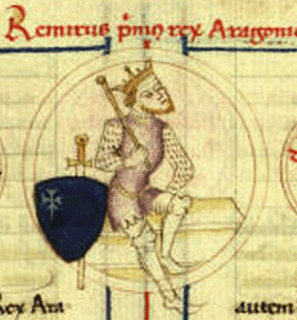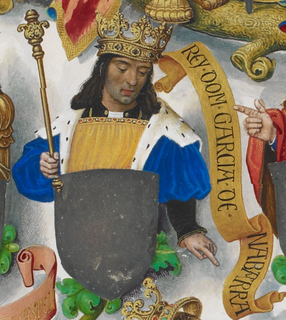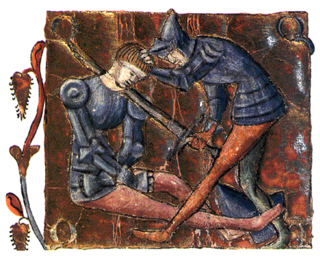| War of the Three Sanchos | |||||||||
|---|---|---|---|---|---|---|---|---|---|
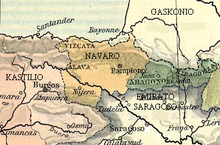
| |||||||||
| |||||||||
| Belligerents | |||||||||
| Commanders and leaders | |||||||||
The War of the Three Sanchos (Spanish : Guerra de los Tres Sanchos) was a brief military conflict between three Spanish kingdoms in 1065–1067. The kingdoms were all ruled by Jiménez kings who were first cousins: Sancho II of Castile, Sancho IV of Navarre, and Sancho Ramírez of Aragon, all grandsons of Sancho the Great. The primary source for the war is the thirteenth-century Primera crónica general .

Spanish or Castilian is a Romance language that originated in the Castile region of Spain and today has hundreds of millions of native speakers in the Americas and Spain. It is a global language and the world's second-most spoken native language, after Mandarin Chinese.
The Jiménez or Giménez/Ximenes, alternatively called the Jimena, the Sancha, the Banu Sancho, the Abarca or the Banu Abarca, were a Basque/Iberian ruling family from the 10th century to the 13th century.

Sancho Ramírez was King of Aragon from 1063 until 1094 and King of Pamplona from 1076 under the name of Sancho V. He was the eldest son of Ramiro I and Ermesinda of Bigorre. His father was the first king of Aragon and an illegitimate son of Sancho III of Pamplona. He inherited the Aragonese crown from his father in 1063. Sancho Ramírez was chosen king of Pamplona by Navarrese noblemen after Sancho IV was murdered by his siblings.
Contents
The brief war was ignited in part by the strife left over from the division of the kingdom of Sancho the Great in 1035. That division had left Navarre with a supremacy over the "petty kingdoms" (regula) of Castile and Aragon, but by 1065 Navarre was a vassal of Castile (now joined with the Kingdom of León). In 1065 Ferdinand the Great, the Castilian monarch died and his kingdom was divided between his sons, with the eldest, Sancho, taking Castile. Sancho of Castile was covetous of the lands of Bureba and Alta Rioja. Ferdinand had helped reconquer them from the Caliphate, but then had ceded them to his elder brother García Sánchez III of Navarre, the father of Sancho IV.

A vassal is a person regarded as having a mutual obligation to a lord or monarch, in the context of the feudal system in medieval Europe. The obligations often included military support by knights in exchange for certain privileges, usually including land held as a tenant or fief. The term is applied to similar arrangements in other feudal societies.
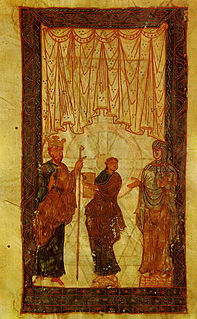
Ferdinand I, called the Great, was the Count of Castile from his uncle's death in 1029 and the King of León after defeating his brother-in-law in 1037. According to tradition, he was the first to have himself crowned Emperor of Spain (1056), and his heirs carried on the tradition. He was a younger son of Sancho III of Navarre and Muniadona of Castile, and by his father's will recognised the supremacy of his eldest brother, García Sánchez III of Navarre. While Ferdinand inaugurated the rule of the Navarrese Jiménez dynasty over western Spain, his rise to preeminence among the Christian rulers of the peninsula shifted the locus of power and culture westward after more than a century of Leonese decline. Nevertheless, "[t]he internal consolidation of the realm of León–Castilla under Fernando el Magno and [his queen] Sancha (1037–1065) is a history that remains to be researched and written."
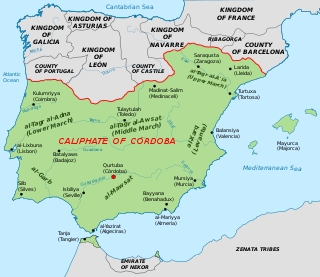
The Caliphate of Córdoba was a state in Islamic Iberia along with a part of North Africa ruled by the Umayyad dynasty. The state, with the capital in Córdoba, existed from 929 to 1031. The region was formerly dominated by the Umayyad Emirate of Córdoba (756–929). The period was characterized by an expansion of trade and culture, and saw the construction of masterpieces of al-Andalus architecture. In January 929, Abd ar-Rahman III proclaimed himself Caliph of Córdoba, replacing thus his original title of Emir of Córdoba. He was a member of the Umayyad dynasty, which had held the title of Emir of Córdoba since 756.
After an initial series of frontier raids, Sancho IV of Navarre asked for an alliance from Sancho Ramírez of Aragon. Most of the war took place in the region of Burgos and La Rioja. The war was also fought over Castile's ability to take part in the Reconquista, a capacity which had been diminished by the division of Ferdinand's kingdom in 1065. Sancho of Castile did try to extend his influence over the Muslim taifa of Zaragoza, which owed him parias . According to the twelfth-century Crónica Najerense , a battle was fought during which campaign his alférez , Rodrigo Díaz de Vivar, defeated his Navarrese counterpart, Jimeno Garcés, and gained the nickname campi doctor or "master of the field [of battle]", later to become famous in Spanish literature as el Campeador. [1]

Burgos is a city in northern Spain and the historic capital of Castile. It is situated on the confluence of the Arlanzón river tributaries, at the edge of the Iberian central plateau. It has about 180,000 inhabitants in the actual city and another 20,000 in the metropolitan area. It is the capital of the province of Burgos, in the autonomous community of Castile and León. Burgos was once the capital of the Crown of Castile, and the Burgos Laws or Leyes de Burgos which first governed the behaviour of Spaniards towards the natives of the Americas were promulgated here in 1512.

The Reconquista is a name used in English to describe the period in the history of the Iberian Peninsula of about 780 years between the Umayyad conquest of Hispania in 711 and the fall of the Nasrid kingdom of Granada to the expanding Christian kingdoms in 1492. The completed conquest of Granada was the context of the Spanish voyages of discovery and conquest, and the Americas—the "New World"—ushered in the era of the Spanish and Portuguese colonial empires.

In the history of the Iberian Peninsula, a taifa was an independent Muslim-ruled principality, of which a number were formed in Al-Andalus after the final collapse of the Umayyad Caliphate of Córdoba in 1031. Most of these were emirates, but there was one oligarchy, Seville.
Between August and September 1067 Sancho Ramírez led a counterattack against Castile. Tradition is divided over who had the victory, the Chronicle of San Juan de la Peña attributes a rout to the Navarrese and Aragonese at Viana, while the Primera crónica attributes victory to Sancho of Castile. Ramón Menéndez Pidal and Bernard F. Reilly accept the latter tradition, Reilly citing a donation of December 1167 to the monastery of Oña by a Flaino Oriolez dominator Tetelie, a landholder in the Trespaderna district of the upper Ebro Valley. The participation of a Castilian magnate from the Navarrese border in an act by which Sancho formally defined the jurisdiction of the Diocese of Oca (the only bishopric in Castile) strongly suggests that Sancho was in a strong position. [2] The chronicler of San Juan de la Peña, a Navarrese source, wrote that Sancho of Castile was forced to raise the siege of Viana and flee on a horse bedecked only in its halter; that he subsequently convinced Abd ar-Rahman of Huesca to go to war with Aragon; and that Sancho Ramírez eventually made peace with him anyway.

The Chronicle of San Juan de la Peña is an Aragonese chronicle written in Latin around before 1359 in the monastery of San Juan de la Peña at the behest of Peter IV of Aragon. It was the first general history of Aragon and was probably designed both to justify the royal prerogatives of the Crown of Aragon against the baronage and to match the comparable Castilian work of a century earlier, the Estoria de España. Between 1369 and 1372, Navarro-Aragonese and Catalan translations were produced.
Viana is a town and municipality located in the province and autonomous community of Navarre, northern Spain. Cesare Borgia is buried there.

Ramón Menéndez Pidal was a Spanish philologist and historian. He worked extensively on the history of the Spanish language and Spanish folklore and folk poetry. One of his main topics was the history and legend of El Cid. He was nominated for a Nobel Prize 23 times, the most nominated person, three times more than the second most nominated person, André Malraux.
Castile retook Álava, the Montes de Oca, and Pancorvo, as well as Bureba and Alta Rioja, but the conflict ended in a stalemate 1067 when the death of Sancha of León, Ferdinand's widow, opened the way to war between Ferdinand's sons. [3] The central issue in the conflict, the possession of the border territories, was resolved in 1076 when Sancho IV of Navarre was assassinated by his own brother and his kingdom partitioned between Sancho Ramírez of Aragon, who became king of Navarre as Sancho V, and Alfonso VI of León and Castile, who received the disputed lands.

Álava or Araba, officially Araba/Álava, is a province of Spain and a historical territory of the Basque Country, heir of the ancient Lordship of Álava, former medieval Catholic bishopric and now Latin titular see.

Montes de Oca is a comarca located east of the province of Burgos, in the autonomous community of Castile and León. It is bounded on the north by La Bureba, south by the Sierra de la Demanda comarca, on the east by the province of La Rioja and west by the Alfoz de Burgos.

Sancha of León was a Queen of León.
